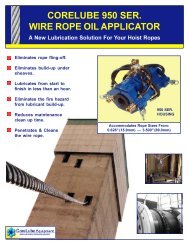OSU REPORT - CORELUBE EQUIPMENT
OSU REPORT - CORELUBE EQUIPMENT
OSU REPORT - CORELUBE EQUIPMENT
You also want an ePaper? Increase the reach of your titles
YUMPU automatically turns print PDFs into web optimized ePapers that Google loves.
The “CORE-LUBE”<br />
Wire Rope Recycling Lubricator<br />
By Ken Palfrey, <strong>OSU</strong><br />
With<br />
The Ship Operations Staff, <strong>OSU</strong><br />
Since our evaluation of the Brooke Ocean Technology (BOT) “Cable maintenance<br />
System” we have-continued to seek out competing cable lubricators with the goal of finding<br />
one with higher lubricant application pressures. In several attempts with the BOT device<br />
we were unable to develop lubricant pressures in excess of 5 PSI without excessive drip<br />
and spatter. At this pressure, which was lower than specified by the manufacturer, some<br />
beneficial lubrication was achieved but the lubricant did not fully penetrate the strands of<br />
wire rope or fully coat the second wire layer of EM cable. See our report “A Cable Maintenance<br />
System” of August 1989 and supplement of 29 January 1990. So far BOT has not<br />
offered any improvements to their device since these reports.<br />
The Core-Lube System is manufactured by B&C Wireline Ltd.. This relatively small<br />
company specializes in the design of equipment for the petroleum industry. The Core-Lube<br />
device has been successfully used on oceanographic wire ropes and EM cables at the<br />
Institute of Ocean Sciences, a UNOLS/RVOC member. The Core-Lube System is best<br />
described by Figure 1.<br />
With the encouragement of Dr. Richard W. West of the National Science Foundation,<br />
a manufacturer’s demonstration and a UNOLS evaluation of-the Core-Lube System<br />
was scheduled for 20 August 1991 at Newport, Oregon using R/V WECOMA. Dr. West<br />
also authorized the reprogramming of equipment grant funds to purchase a Core-Lube<br />
System for further testing should the evaluation indicate strong potential for the device in<br />
support of UNOLS vessel operator institutions. Ron Chisholm, President of B & C Wireline,<br />
provided and demonstrated the Core-Lube System as scheduled. Alan Metzler, Vice President<br />
and Technical Director of PMI Industries, also participated and is a distributor of the<br />
Core-Lube System.<br />
For the demonstration and evaluation the 1/2" 3x19 wire rope spooled on<br />
WECOMA’s coring winch was selected. This wire is an early Macwhyte, length 30,000 f t<br />
(9000 M), received in December 1987 and placed in service August 1988. At the time of<br />
the evaluation the wire showed considerable surface rust throughout its working length<br />
with little intact galvanizing or zinc oxide visible. It had not been cleaned or lubricated<br />
throughout its service life. The wire had experienced 377 cycles to a maximum length of<br />
6200 M and maximum tension of 10,500 lbs during a four year service life, which we believe<br />
to be below average use. We felt this wire would provide the most challenging test of<br />
the Core-Lube System.<br />
The wire rope was spooled off WSCOMA’s winch drum onto a shore side storage<br />
reel on 19 August, the day prior to the demonstration and evaluation. The wire was not<br />
cleaned deliberately in order to evaluate the system’s advertised capability to remove<br />
trapped moisture and detrimental particles (salt, rust, etc.) from the wire rope. The Core-<br />
Lube System was set up and operated on 20 August according to B&C Wireline’s Instruction<br />
Manual, Figure 2. Photographs of the setup are contained in (Figures 3 & 4). The<br />
system performed flawlessly. Cable line speeds of up to 100 Meters/Min. ( 300 Feet/Min.)<br />
were achieved. Lubricant application pressures up to 60 Psi were achieved without leakage<br />
from the housing. A pressure of 40 Psi was believed adequate for full penetration of<br />
the lubricant and was held throughout the full length without any difficulty or appreciable<br />
loss of lubricant. Five and one-half (5.5) gallons of “Pre-Lube 19” was used. The small



